
July 2014 Newsletter
Click here to view this newsletter in a .pdf with a white background for easy
printing.
Jim’s Doings
|
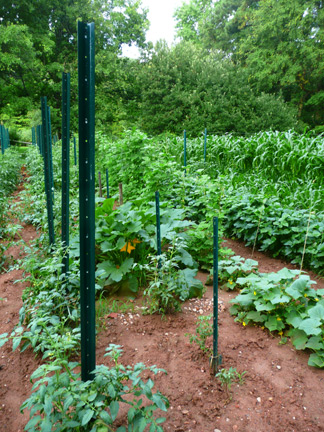
This is how my main garden
(one of four separate plots)
looks at present. |
June has been fairly quiet in these parts and has included
dealing with some of the health irritants which come with age (I
weigh too much, exercise too little, enjoy fine food far beyond
reason, and simply ain’t, to use a phrase from a fishing buddy,
“as catty as I used to be”). I’ve gotten a decent amount of
writing done, including my premier column for the first issue of
a magazine with a concept I really like, Outdoor Heritage.
I’ll give more information in an upcoming newsletter. Beyond
that there’s been a celebration of my grand-daughter’s reaching
her teen years (we jointly celebrated that and Father’s Day with
a really nice meal out), the gardening efforts which form the
crux of this month’s newsletter, and the typical daily stuff I
try to churn out of an active (although some might say
periodically addled) mind.
I’ll be spending most of July researching on Archibald Rutledge,
although there’s a wedding to attend (a fine young man I’ve seen
grow up in the Smokies), daily chores to do, and what have you.
Enough of that though, let’s get to one of the “constants” of
the month of July which has given me a full measure of pleasure
one decade after another. |
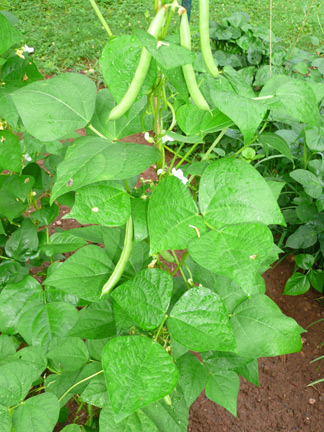
Nantahala runner beans—
this is a century-plus old heirloom variety shared with me by a
good friend from the mountains,
Ken Roper. |
Back to Top
July Means Gardening Joys
If I was tasked to name say 10 things which brought me great joy
as a youngster, most of them would involved pleasures associated
with leisure time—hunting small game, fly fishing for trout,
trot lining and cane poling for catfish in the nearby river,
picking berries, camping, swimming, and other aspects of just
being a boy growing up in the heart of North Carolina’s Great
Smokies. Yet one youthful source of pure delight, and it has
stood the test of time wonderfully well, involved all the myriad
aspects of raising a garden. Plenty of hard work was involved,
but the simple delights of enjoying products of the sweat of
one’s brow, walking newly hoed rows to look at corn and beans,
or seeing a labor of love’s end product through harvesting all
were deeply meaningful.
Gardening was a part of my life as far back as my memory goes.
Daddy and Grandpa Joe both took gardening as a matter of serious
concern. Part of this was sheer necessity—the food they produced
made a significant difference in the family budget—but there is
also no doubt whatsoever that they found the whole process
enjoyable. From when the ground was first turned in early spring
(there were no tillers; everything was done by horse, plow, and
harrow followed by hand labor with a hoe and other implements)
until everything was harvested in the fall, there was always
work to be done.
Each step, from planting the first seeds of spring vegetables or
putting out onion sets and cutting up seed potatoes right
through to the gathering of October beans and pumpkins after the
first frost, was part of the rhythm of life. Some things, such
as feeding chickens and slopping hogs, went on throughout the
year, but gardening was a March to October deal. It’s been well
over 60 years since I first raised my “own” garden (Daddy let me
have a little spot which I worked up with a spading fork), and
in my mind’s eye I can still see those Charleston Grey
watermelons growing until they finally reached maturity in
mid-August. A few years later, matters got a bit more ambitious,
but it wasn’t until I had finished undergraduate school and was
out on my own that garden became more than a hobby. Since I was
in my 20s it has been an ongoing, mostly delightful love affair.
As every gardener knows, there are some down times, and it seems
most of mine revolve around dealing with critters. While I have
the normal problems such as blight, nematodes, squash stem
borers, Japanese beetles, and the like, my major sources of
misery come from deer and squirrels, with occasional intrusions
from ‘coons and rabbits thrown in for good measure. I also have
trouble with terrapins (really painted turtles but we always
called them terrapins or “tarpins”) taking a bite or two out of
any ripe tomato they can reach, and forget growing cantaloupes.
They wait until the melon is on the edge of perfection and then
eat into it.
In the case of the bushytails, I’ve been working on them with a
will, and I would imagine that over the past month I’ve averaged
killing one a day. Somehow, it doesn’t seem to make any
difference other than to increase their awareness of the fact
that my appearance sends an instant signal to light a shuck to
some place far away. They play hob with the bird feeders, make
me spend a lot of extra time pulling up oak and pecan sprouts
from nuts they have planted, make trying to harvest pecans an
exercise in futility, and more. This year they have pretty well
denuded a pear tree of fruit long before it reached the ripe
stage, they are getting figs as soon as they ripen, and seem to
have a penchant for taking one or two bites out of green
tomatoes.
Deer are a major problem on many fronts—they work on newly
sprouted or planted stuff of all kinds, can devastate a patch of
corn as it reaches the milk stage, nip away at new growth on my
raspberries and muscadines with a will, and generally seem to
stay a bit ahead of me in an ongoing war that has no foreseeable
conclusion. I’ve tried tape, tin pie pans, urine, hair, netting,
perfume, hair spray, and perhaps two dozen other “solutions.”
All work temporarily; none work for long. The same is true,
albeit to a much smaller degree, with rabbits. Still, all too
often I find evidence of rabbit browsing (they cut stems at a 45
degree angle while deer clip them pretty much straight across),
and they are particularly fond of young beans, limas, and
crowder peas.
Then there are the birds. I love to watch them feed, and we go
through a considerable amount of bird food each year, along with
sweet water for hummingbirds. ‘Coons have gotten into the
hummingbird act (or at least that’s what I think it is, because
the raids come at night and are undertaken by some type of
climbing critter) and have taken to emptying and often knocking
down our feeder. My main bone to pick with birds focuses on
blueberries and to a lesser degree on raspberries and thornless
blackberries. Some years I cover them with netting (a
considerable undertaking, because if you leave an opening birds
will find it); others I just write off substantial losses. This
year I’m taking the lazy approach and thus far the blackberries
are faring pretty well although there are ongoing inroads on the
blueberries. I don’t mind sharing but sometimes the birds, and
robins, brown thrashers, and mockingbirds are the worst, have a
decidedly different idea of what constitutes their share from
what I have in mind.
Usually the blueberry patch I planted some 40 years ago and
which now sports plants eight or nine feet high, has far more
berries than we need. That is not the case this year, and that’s
another reason for me to be a bit irritated with the birds.
Although the explanation lies beyond my understanding, some
bushes are covered while others, heavy bearers in the past, have
few if any berries. Still, we have plenty for our needs so I
guess I shouldn’t complain, and blueberries will be a part of
our daily diet for the next six weeks or so. This month’s food
section is also devoted entirely to this healthy, delicious, and
relatively easy to cultivate plant. In fact, once established,
blueberries need little other than mulch, being kept free of
weeds, and maybe a bit of fertilizer every other year. They do
require acidic soil, and in times of extreme drought I usually
give them a bit of a hands up with the soaker hose. Most years
no watering is needed.
Beyond that, there’s a bit of daily war at dawn with Japanese
beetles (I knock them off heavily laden muscadines into a bucket
with a couple of inches of water and a dash of liquid soap in
it), keeping an eye out for any squirrel who dares give me an
opportunity to shoot, and the genuine pleasure of just walking
around in the gloaming surveying what a lot of hard work and the
good earth have given me.
|
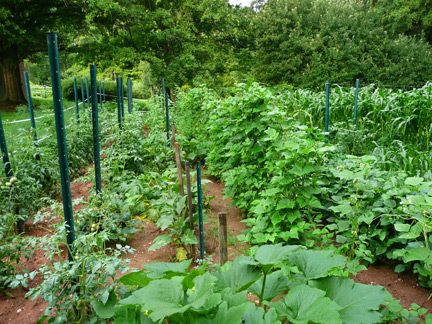
Another view of the main garden—others hold a big patch of
blueberries, three rows of okra, late tomatoes, etc.
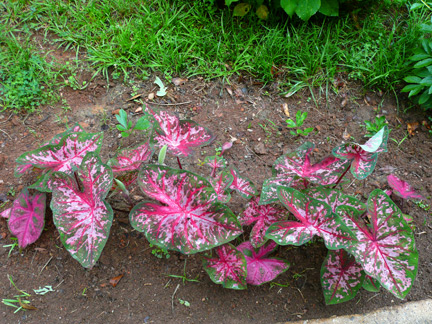
Caladiums add a delightful touch of color
to semi-shady spots around the yard.
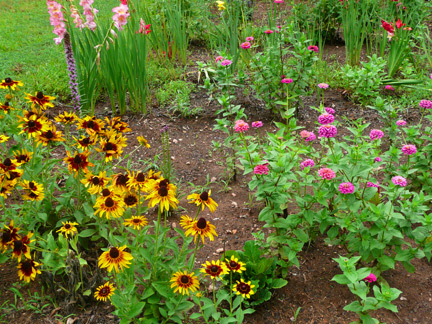
A flower garden near the street adds color, provides cut flowers
for the house, and brings nice comments from neighbors.
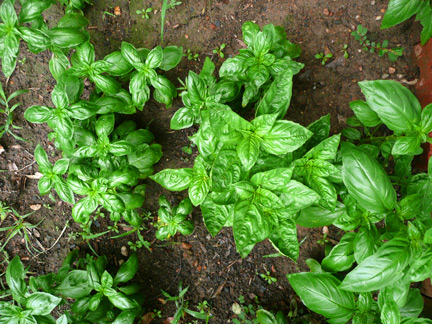
I always plant a small patch of basil. It is wonderful fresh
with home-grown tomatoes and fresh mozzarella cheese drizzled
with olive oil, not to mention being the key ingredient for
basil butter and a bunch of Italian dishes.
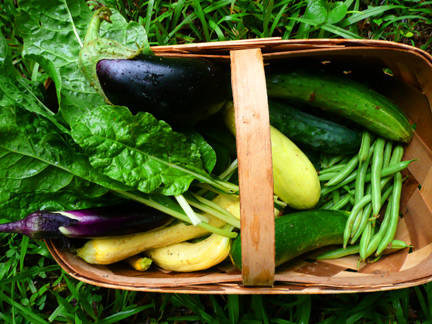
Each morning in July brings the pleasure of harvesting.
Today’s harvest included a peck of veggies—yellow squash,
zucchini, burpless and pickling cucumbers, Swiss chard,
Nantahala runner beans, and two kinds of eggplant. We have
already had the first ripe tomatoes, but none needed picking
today.
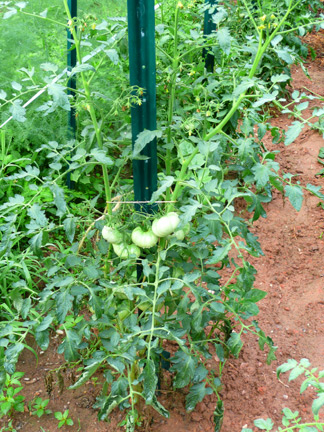
One of 48 Cherokee Purple tomato plants I have in the ground.
They are roughly three weeks from ripeness, thanks to a wet
spring and me getting the plants in late, but in time they will
bring a wonderful reward. This heirloom variety is my favorite
tomato, although I also have Lemon Boy, Park’s Whopper, Better
Boy, Early Girl, and volunteer tommytoes.
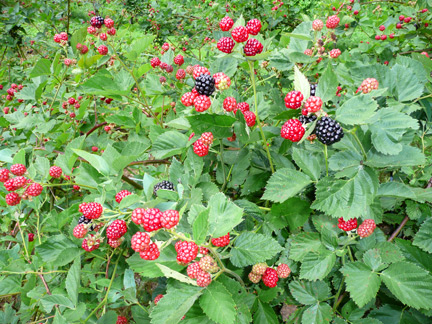
Thornless blackberries give promise of cobblers and jam in the
immediate future. |
Back to Top
A Bevy of Blueberry Delights
FRESH BLUEBERRY PIE
1 baked 9-inch pie shell (pastry or graham cracker)
4 cups fresh blueberries, divided
1 cup sugar
3 tablespoons cornstarch
¼ cup water
¼ teaspoon salt
¼ teaspoon cinnamon (optional)
1 tablespoon butter
Line pie shell with two cups of the fresh blueberries. Cook remaining
two cups of the berries with sugar, cornstarch, water and salt over
medium heat until thickened. Remove from heat. Add cinnamon and butter
and cool slightly. Pour over berries in shell Refrigerate. Serve with
whipped cream.
BLUEBERRY TIPS AND TIDBITS
-
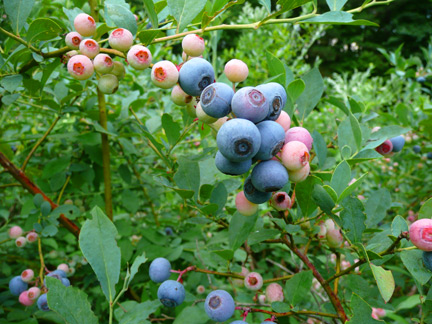 Make a blueberry pizza for dessert. Use sugar cookie dough, top with
sweetened cream cheese blended with whipped topping and a layer of
blueberry sauce (cook two cups of blueberries and two-thirds cup of
sugar and thicken with cornstarch and water). Reserve additional
fresh blueberries for the topping. Make a blueberry pizza for dessert. Use sugar cookie dough, top with
sweetened cream cheese blended with whipped topping and a layer of
blueberry sauce (cook two cups of blueberries and two-thirds cup of
sugar and thicken with cornstarch and water). Reserve additional
fresh blueberries for the topping.
-
Make a blueberry chutney (perhaps mixed with mangos) as a complement
to game dinners.
-
Blueberries go wonderfully well with fresh melons such as honeydew,
cantaloupe and watermelon.
-
Add blueberries to your favorite muffin, waffle, pancake, or pound
cake batter.
-
Stir blueberries into plain yoghurt.
-
Make a summertime ambrosia with blueberries, fresh peaches,
raspberries, and pineapple. Top with coconut.
-
Partially fill an ice cream cone with blueberries then top off with
a scoop of vanilla ice cream. Tell children (or the young at heart
no matter their age) they are eating an ice cream surprise and let
them discover the surprise as they get into the cone.
BLUEBERRY SALAD
2 cups blueberries
1 (six-ounce) package black cherry gelatin
1 cup water
1 (8 1/2 –ounce) can crushed pineapple, undrained
1 small carton whipped cream
1 (3-ounce) package cream cheese, softened
½ cup finely chopped pecans
Place one cup berries in a saucepan, cover with water and simmer until
berries are tender. Drain and reserve the juice. Add enough water to the
blueberry juice to make two cups. Heat juice to boiling and add gelatin;
stir until gelatin is dissolved. Add one cup cold water, pineapple,
cooked blueberries, and a cup of uncooked blueberries. Pour into a 9 x
13-inch dish and refrigerate until firm.
Beat softened cream cheese, add nuts and fold in whipped topping. Mix
well. Spread over congealed salad and chill for at least two hours
before serving.
BLUEBERRY COBBLER
1/2 stick butter
4 cups blueberries, rinsed and drained (frozen berries may be used—drain
well)
1 teaspoon freshly squeezed lemon juice
Topping
1 cup self-rising flour
1 cup sugar
1 teaspoon vanilla flavoring
½ cup milk
Preheat oven to 375 degrees. Melt butter in an 8 x 8-inch baking dish.
Combine blueberries and lemon juice in bowl; add sugar and mix well.
Spoon blueberries into baking dish over melted butter. Do not stir.
Combine flour and sugar in a small bowl. Add vanilla to milk and mix
into flour and sugar. Pour topping over blueberries and bake for 30-45
minutes or until bubbly and golden brown. Serve with whipped cream or
vanilla ice cream.
BLUEBERRY BUCKLE
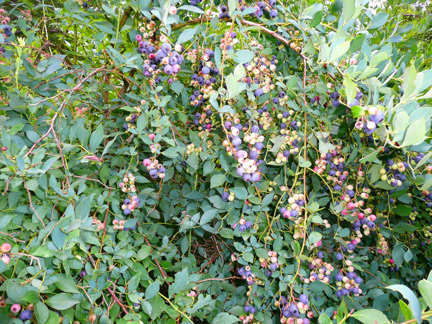 4 cups blueberries 4 cups blueberries
½ cup maple syrup
1 teaspoon cinnamon
¼ cup cornstarch
1 ¼ cups flour
¾ cup brown sugar
½ cup butter, softened
½ teaspoon almond extract
Gently stir blueberries, maple syrup, cinnamon and cornstarch. Pour into
a 9-inch square baking dish that has been sprayed. In a separate bowl,
blend flour and brown sugar. Cut butter and almond extract into flour
and sugar until mixture is crumbly. Sprinkle over berries and bake at
375 degrees for 30-45 minutes or until lightly browned and bubbly. Serve
warm with ice cream, whipped cream or milk.
Back to Top
Thank you for subscribing to the
Jim Casada Outdoors
newsletter.
Feel free to contact Jim with your comments, questions
or suggestions at jc@jimcasadaoutdoors.com.
|











